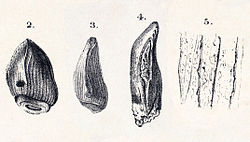History and taxonomy
Richard Owen named the genus for a now-lost tooth, part of the collection of naturalist Joseph Chaning Pearce, found near Bradford-on-Avon, but did not assign it a specific name at the time. The generic name is derived from Greek καρδία, kardia, "heart", and ὀδών, odon, "tooth", in reference to its heart-shaped profile. [2] A few years later, in 1844, he added the specific name rugulosus, meaning "wrinkled" in Latin. [3] Cardiodon was the first sauropod given a formal name to, though Owen was at the time completely unaware of the sauropod nature of the find.
Within a few decades, he and others were viewing Cardiodon as a possible synonym of his most well-known sauropod genus, Cetiosaurus . [4] [5] Richard Lydekker formalized this view in a roundabout way in 1890, by assigning Cetiosaurus oxoniensis to Cardiodon on the basis of teeth from Oxfordshire associated with a skeleton of C. oxoniensis. [6] He also added a second tooth (BMNH R1527) from the Great Oolite near Cirencester, Gloucestershire. [6] More typically, Cardiodon has been assigned to Cetiosaurus, sometimes as a separate species Cetiosaurus rugulosus, [7] in spite of its priority.
In 2003, Paul Upchurch and John Martin, reviewing Cetiosaurus, found that there is little evidence to assign the C. oxoniensis teeth to the skeleton, and the "C. oxoniensis" teeth differ from the Cardiodon teeth (Cardiodon teeth are convex facing the tongue); therefore, they supported Cardiodon being retained as its own genus. [8] Upchurch et al. (2004) repeated this assessment, and found that though the teeth have no known autapomorphies, they are those of a eusauropod. [9] More recently, Royo-Torres et al. (2006), in their description of Turiasaurus , pointed out Cardiodon as a possible relative to their new, giant sauropod, placing it in the Turiasauria. [10] Earlier, Cardiodon had been usually assigned to the Cetiosauridae or a Cardiodontidae of its own.
This page is based on this
Wikipedia article Text is available under the
CC BY-SA 4.0 license; additional terms may apply.
Images, videos and audio are available under their respective licenses.












